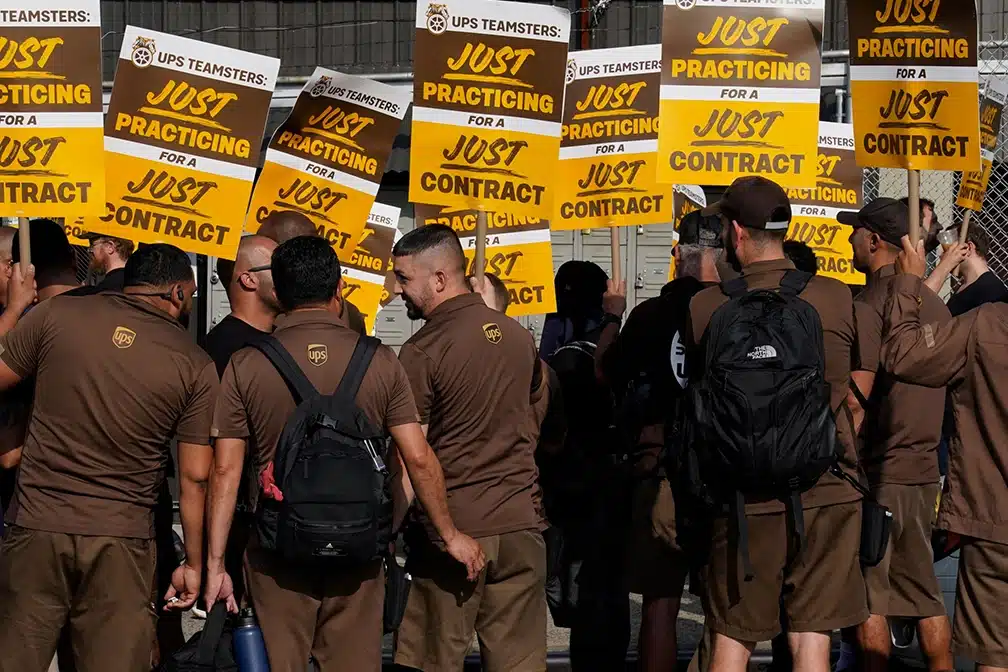Electric Vehicle Revolution: Quebec's $59M Investment in Trucking Electrification Signals a Bright Future for Truck Drivers and the Environment.
More
May 19, 2024 4:17 pm

The negotiation standoff between UPS and the Teamsters union has brought both sides to the precipice of a strike, with the potential to disrupt the parcel market and create significant challenges for shippers. As the expiration date of the current labor agreement approaches, tensions are high, and the looming strike poses a substantial risk for both UPS and its workers. This article explores the potential consequences of a UPS strike, including the intensification of competition for any available additional capacity and its implications for the market and key stakeholders.
The Teamsters union, representing over 340,000 UPS workers, has been engaged in negotiations with UPS as their labor agreement nears its expiry on July 31. The union has made it clear that its members will not work beyond the contract’s expiration, with an overwhelming 97% of members authorizing a strike in a recent vote. This situation is reminiscent of the 1997 UPS strike, during which the International Brotherhood of Teamsters (IBT) and its members shut down UPS operations for 15 days, resulting in significant financial losses for UPS. Eventually, the Teamsters emerged as winners, securing improved benefits and hourly wages.
Today, the parcel market has evolved significantly since the 1997 strike, with an increased overall capacity and a greater number of carriers. However, the potential for a strike poses a more significant threat to both UPS and the Teamsters due to the possibility of permanently lost volume. According to the third-quarter 2023 release of the TD Cowen/AFS Freight Index, compiled by AFS Logistics and TD Cowen, this long-term threat is a cause for concern for Teamsters workers.
In the immediate aftermath of a strike, shippers would face elevated costs and limited alternatives to shift their volumes away from UPS. Deadlines imposed by FedEx and regional carriers have already passed, leaving shippers with fewer options to secure alternative capacity. FedEx, prioritizing the protection of its existing customers, has urged shippers to initiate shipments with the company promptly or open new accounts for those considering shifting volume to FedEx. Despite concerns about a UPS strike, shippers have shown confidence in a timely resolution and the value of the established discounts offered by UPS. Shifting volumes to another carrier at this stage could lead to lower discount tiers and substantial additional costs.
In the event of a strike, the market would struggle to absorb the approximately 20 million parcels handled by UPS daily, resulting in a significant backlog of packages. Shippers, particularly those in high-value sectors like healthcare and pharmaceuticals, would find themselves in fierce competition to secure any available additional capacity to move priority volumes. Michael McDonagh, President of Parcel for AFS, predicts that the intense demand for additional capacity would drive shippers to seek alternatives to avoid overwhelming their own warehouse space.
Jason Miller, a supply chain professor at Michigan State Eli Broad College of Business and a veteran transportation economist, suggests that the market could potentially absorb around 20% of the stranded UPS volume. He points out that there is a significant amount of shadow capacity available within the courier and messenger sector. The average hours worked per employee per week in this sector has declined since pre-COVID times, providing an opportunity for additional capacity utilization. However, Miller notes that the industry’s shadow capacity is limited due to the friction associated with onboarding new business quickly.
Taking into account the 13% shadow capacity and UPS representing approximately 33% of employment in its segment and 25% of parcels, Miller considers a 20% figure to be a reasonable estimation of the volume absorption capacity in the event of a strike. Comparing the potential impact of a UPS strike to a scale of 1-7, with 1 representing no impact and 7 signifying an economic catastrophe, Miller places the current threat at a level 5. He notes that if this situation had occurred in 2021, the impact would have been rated as a 6. By way of reference, Miller cites a railroad strike, narrowly averted in late 2022, as a potential level 7 catastrophe, while a closure of Yellow, involved in a separate tussle with the Teamsters and burdened by mounting debt, would likely have a relatively lower impact at a level 2.
As the deadline for the expiration of the UPS labor agreement approaches, the threat of a strike looms over both UPS and the Teamsters union. The potential consequences of a UPS strike are far-reaching and would significantly impact the parcel market and its stakeholders. Shippers would face increased costs and limited options for shifting volumes, while the demand for additional capacity would intensify competition among carriers. Understanding the potential risks and outcomes associated with a UPS strike is essential for industry participants and observers as they navigate this critical labor negotiation period.
Electric Vehicle Revolution: Quebec's $59M Investment in Trucking Electrification Signals a Bright Future for Truck Drivers and the Environment.
MoreCargo theft has become a significant concern within the transportation industry, with an alarming increase in incidents reported in recent years. The year 2023 has witnessed a
MoreRyder's journey through the last quarter brought in an operating revenue of $2.4 billion. That's a 2% climb compared to last year—not a huge leap, but moving
MoreThe American Trucking Associations (ATA) has expressed strong opposition to the Department of Justice's proposed rule of marijuana reclassification.
MoreIn an effort to increase efficiency and sustainability in Trucking, Phillips Industries has launched their new, advanced, stick-on solar panels
MoreThe 2024 CVSA International Roadcheck is scheduled for May 14-16. Over 72 hours, inspectors across the US will conduct nearly
MoreAutomated License Plate Readers are a major advance in law enforcement technology but they raise significant privacy and oversight challenges.
MoreThe EPA's latest emission standards detailed in a final rule issued on March 29 are sparking vigorous debate within the
More